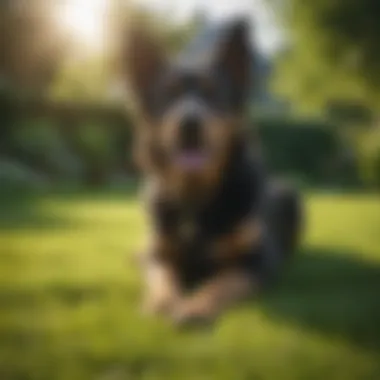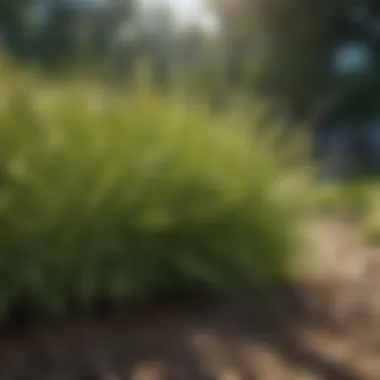Selecting Dog-Friendly Grass Seed for Healthy Lawns


Intro
Selecting suitable grass seed for dog owners requires careful consideration of various factors. Many pet owners desire a lawn that not only stands out in appearance but also promotes the health and safety of their dogs. Dogs often spend a significant amount of time outdoors, exposing them to different types of grasses. Therefore, understanding the characteristics of different grass seed varieties becomes crucial.
This guide will present the most appropriate grass seed types, focusing on digestibility, wear resistance, and allergenic properties. With practical insights, you will be equipped to make informed decisions about your lawn – ensuring it is both aesthetically pleasing and safe for your canine companions.
Research and Data Analysis
In the realm of agriculture and horticulture, the trends influencing grass seed selection are evolving. Dog owners are increasingly leaning towards grass types that can withstand the demands of pet activity. Grass strains that show durability against wear are becoming popular due to their ability to recover quickly from pet-related impacts.
Statistical insights reveal that certain grass types can endure considerable foot traffic and wear. For example, Kentucky bluegrass is known for its regenerative properties, allowing it to bounce back after heavy usage. Conversely, Perennial ryegrass offers quick germination, making it favorable for patching worn areas of a lawn.
"Selecting the right grass variety not only supports the lawn’s health but also significantly contributes to your dog’s wellbeing."
Best Practices and Techniques
Efficient management practices can enhance the health of your lawn and well-being of your dog. Maintaining soil quality is essential for robust grass growth. Regular testing can identify nutrient deficiencies, paving the way for informed fertilization strategies.
When selecting dog-friendly grass seeds, consider the following:
- Aim for varieties like Fescue for its soft blades and tolerance to shade, making it a great option for shaded areas.
- Choose heat-tolerant species, such as Bermudagrass, for those hotter months, ensuring a consistent green lawn that withstands heat stress.
Sustainable horticultural techniques also play a major role. Organic lawn care practices prevent harmful chemicals from affecting your pet. Organic fertilizers and pesticides provide a safer environment, minimizing allergic reactions in dogs.
Pest and Disease Management
Maintaining a healthy lawn ecosystem involves understanding common pests and diseases affecting grass. For instance, grubs can cause notable damage, leading to bare patches on your lawn. Using integrated pest management strategies can mitigate such issues, including natural predators and organic treatment options.
Additionally, keeping the lawn well-aerated helps prevent diseases like fungal infections, which can thrive in overly moist conditions. Implementing a balanced irrigation schedule will keep your grass healthy while reducing the chances of disease spread.
Foreword to Dog-Friendly Grass Seed
Choosing the right grass seed is essential for dog owners who want a safe and comfortable environment for their pets. This section aims to outline why selecting dog-friendly grass seed is crucial for canine health and lawn enjoyment. A well-chosen grass type not only supports the well-being of dogs but also contributes to the durability and beauty of the lawn.
Importance of Choosing the Right Grass Seed
When selecting grass seed, several factors must be considered. The type of grass can influence how a dog interacts with the lawn. Some grass varieties may cause stomach upset or allergic reactions. Thus, understanding the specific needs of your dog is key. Selecting a grass that is resistant to wear and tear is equally important, especially if your dog is energetic and often playing outside.
Additionally, certain grass types can withstand a dog's natural behaviors like digging or running. A well-chosen grass seed reduces the risk of bald patches or lawn damage. Furthermore, if the grass seed is digestible and non-toxic, any ingestion by a curious dog is less likely to pose health risks.
In summary, the implications of selecting the right grass seed extend beyond aesthetic appeal. It impacts your dog's health, the longevity of your lawn, and ultimately, your enjoyment as a pet owner.
Understanding Canine Behavior and Grass Interaction
Canine behavior plays a significant role in how grass is used and affected in your yard. Dogs may dig, chew, or lay on the grass. Understanding these behaviors allows owners to choose the appropriate grass seed that can better tolerate such actions. For example, dogs that enjoy running may require a grass type that is resilient and can recover quickly from heavy foot traffic.
In addition, some dogs have natural tendencies to eat grass, which can lead to digestive issues if the grass contains harmful chemicals. Selecting organic or non-toxic grass seeds minimizes the risk of such incidents. Moreover, knowing specific behaviors helps in choosing grass varieties that are gentle on their paws, especially for breeds more susceptible to foot irritations.
By considering how dogs interact with grass, owners can create an inviting and safe outdoor space. Caring for a dog means being proactive in understanding their behaviors and the impact on your lawn. Selecting the right grass seed is a vital step in fostering a positive relationship between pets and outdoor environments.
Key Characteristics of Dog-Friendly Grass Seed


Selecting the right grass seed entails understanding its key characteristics, especially for dog owners. These characteristics influence not only the longevity of the lawn but also the health and safety of pets. A careful assessment of these qualities ensures an optimal environment for dogs to play and relax. Below are essential attributes to consider.
Digestibility of Grass Varieties
When dogs consume grass, often it can lead to digestive issues or distress. Therefore, the digestibility of grass varieties is of paramount importance. Grass types that are easily digestible reduce the negative impact on a dog's health. Some varieties, like fine fescue, tend to be more digestible. This diminishes the chances of gastrointestinal upset, which is crucial for keeping a pet’s health in check. Grass that is tough and fibrous can cause nausea or vomiting. Thus, opting for grasses that are softer and more palatable is a sensible choice for dog owners.
Tolerance to Heavy Foot Traffic
Dogs are active creatures. They run, jump and play on the lawn daily. Hence, tolerance to heavy foot traffic emerges as a significant factor in grass seed selection. Certain grass varieties demonstrate robust resilience when subjected to constant wear and tear. Tall fescue, for example, is known to withstand heavy use while maintaining its lush appearance. This ability prolongs the life of the lawn despite frequent paws trampling. When selecting grass for a dog-friendly yard, consider varieties that promise durability and can recover quickly from damage.
Resistance to Allergens and Irritants
Allergies in pets can be problematic. Choosing grass seed that exhibits resistance to allergens and irritants can mitigate such issues. Certain grass varieties produce less pollen, which minimizes allergic reactions. Additionally, some types are less likely to harbor pests, which further reduces irritation. This aspect is essential, as it not only ensures the comfort of the dog but also promotes a healthier turf. Varieties like perennial ryegrass often present lower allergenic potential compared to others.
Selecting suitable grass goes beyond aesthetics. It significantly affects your pet’s well-being.
Recommended Grass Seed Types for Dog Owners
Choosing the right grass seed is essential for dog owners. The type of grass can affect not only the aesthetics of a lawn but also the safety and health of pets. Selecting dog-friendly grass seed is vital to ensure that the yard remains a safe and welcoming environment for dogs to play and explore.
The recommended types of grass for dog owners must consider factors like resilience, digestibility, and allergy potential. Each type has unique characteristics that can either benefit or hinder a dog's interaction with the lawn.
Fescue Varieties
Fescue is a popular choice for many dog owners, thanks to its durability and adaptability. Fescue varieties offer features that make them ideal for lawns where dogs frequently run and play.
Fine Fescue
Fine fescue consists of several grass types, including creeping red and chewings fescue. This grass type is known for its fine texture and ability to thrive in shaded areas. Fine fescue is a beneficial option for dog owners as it establishes deep roots, promoting resilience against foot traffic. The key characteristic lies in its tolerance to low fertility soils. However, while it is soft underfoot, it may struggle in high-traffic areas, making it best suited for less active regions of the lawn.
Tall Fescue
Compared to fine fescue, tall fescue offers a coarser blade and greater adaptability to various soil types. It has deep roots that enable it to survive in drought conditions, providing an excellent lawn option for dog owners. Tall fescue is known for its durability and tolerance to wear from a pet's activity. Its unique feature is that it can recover quickly from damage, allowing it to maintain a lush appearance even in a busy yard. However, some dogs may be sensitive to its rough texture, so it's worth considering each dog's comfort
Perennial Ryegrass
Perennial ryegrass is another recommended choice for dog owners. It establishes quickly and grows dense, creating a lush lawn. This type of grass germinates fast and can handle some foot traffic. However, it may struggle in extreme heat or drought conditions. One advantage is its ability to patch and fill in bare spots, making it ideal for lawns with high activity. Another concern is that it can require more frequent mowing to maintain its appearance.
Kentucky Bluegrass
Kentucky bluegrass has a reputation for being one of the most beautiful grass types available. Its dense growth habit makes it an appealing choice. While it is often associated with a picturesque lawn, it possesses both advantages and disadvantages for dog owners. Kentucky bluegrass can handle foot traffic well, but it does require a fair amount of care. It thrives in cool climates and may not perform as well in warmer regions, leading to potential issues. Dogs may also find it irritiating, depending on their sensitivity to grassy textures.
"Choosing the right grass is not only about maintaining beauty; it's about ensuring the safety and comfort of our canine companions."
Considerations for Lawn Maintenance with Dogs
Maintaining a lawn that is not only visually appealing but also safe for dogs requires careful planning and attention. Regular maintenance becomes essential because a dog's interactions with the grass can lead to wear and potential health concerns. By understanding how to effectively maintain a lawn while accounting for the unique needs of dogs, pet owners can create a space that benefits both their pets and the environment.
Watering Techniques
Proper watering is crucial for the health of grass in a dog-friendly lawn. Dogs may cause uneven wear on grass, so ensuring the area is well-hydrated helps promote recovery. Early mornings or late afternoons are the best times for watering, as this minimizes evaporation. Deep watering encourages roots to grow stronger, making the grass more resilient to dog traffic.
- Avoid overwatering, as this can lead to soggy areas and unwanted mud.
- Use a sprinkler system that provides even distribution without puddling.
- Consider installing a rain gauge to monitor water levels effectively.


Mowing Practices
Regular mowing is essential for maintaining grass health and preventing damage from dog activity. Keeping the grass at an appropriate height not only enhances the lawn's appearance but also ensures that it remains lush and healthy. Mowing should be done when the grass is dry to prevent clumping and uneven cuts.
- Set the mower blades at a height suitable for the grass type selected. For example, fescue should be taller than Bermuda grass.
- Vary the mowing pattern each time; this prevents grass from flattening and encourages an upright growth.
- Keep mower blades sharp to promote clean cuts and reduce grass stress.
Pest Control Strategies
Pests can pose a significant risk to both lawns and dogs. Implementing safe pest control strategies is essential in protecting the health of pets. Integrated Pest Management (IPM) is a proactive approach that combines various methods to control pests while ensuring safety.
- Use natural deterrents and barriers instead of harmful chemicals.
- Maintain lawn health to minimize pest attraction; healthy grass is less vulnerable to infestations.
- Regular inspections can help in early detection of potential pest problems before they escalate.
Important: Always prioritize pet-safe pest control options to reduce exposure risk for dogs.
By addressing these maintenance considerations, dog owners can foster a safe and attractive lawn environment. For further reading, valuable resources can be found at Wikipedia, Britannica, Reddit, and Facebook.
Understanding the Ecological Impact of Grass Seeds
Understanding the ecological impact of grass seeds plays a pivotal role in selecting the right varieties for lawns shared with dogs. Grass seeds are not merely selections for appearance or feel; they contribute extensively to local ecosystems. Choosing the correct type can enhance biodiversity, support wildlife, and mitigate landscape issues. It is critical to consider how grass choices affect not only the immediate environment but also broader ecological systems over time.
Looking at native grasses, they often exhibit greater resilience in local climates and soil conditions. Additionally, they require less water and fewer chemical inputs, benefitting both the environment and the dog owner.
Responsible lawn care practices also contribute to the ecological balance. Using sustainable practices helps ensure that the lawn remains a safe haven for dogs. It is essential to avoid harsh chemicals that can linger in the soil and harm other living organisms. This section explores the options and necessitates thoughtful decisions in grass selection.
Native Grass Options
Native grass options vary based on geographical location. They are adapted to the local climate, soil type, and ecosystem, making them an excellent choice for those looking to align their lawn with environmental sustainability. For instance, in regions like the Midwest, types like Little Bluestem and Big Bluestem offer robust growth while requiring minimal maintenance.
Benefits of native grasses include:
- Lower water usage
- Resistance to pests and diseases
- Support for local fauna, like birds and insects
Opting for native grass not only benefits your lawn's sustainability but can significantly decrease your overall lawn care effort. It aligns with the natural habitat, allowing any surrounding wildlife to thrive while ensuring your dog's safety in their environment.
Sustainable Practices in Lawn Care
Sustainable practices in lawn care refer to methods that aim to reduce resources while minimizing the impact on the environment. Such practices in lawn care focus on long-term viability. They are beneficial not only for maintaining a healthy lawn but also all aspects of an ecosystem. Here are some pivotal practices to consider:
- Natural Fertilizing: Utilizing compost or organic fertilizers contributes to healthier soil without introducing harmful chemicals.
- Smart Watering: Implementing efficient irrigation practices, like drip systems or rainwater collection, conserves water and promotes healthier grass growth.
- Diverse Planting: Mixing grass varieties can lead to a more resilient lawn and supports biodiversity.
Implementing these strategies leads to better lawn health, which is essential for the welfare of dogs as it reduces exposure to harmful substances.
"The most sustainable lawns support local ecosystems, providing dogs safe environments to play and thrive."
By embracing both native grass options and sustainable lawn care practices, dog owners can create a vibrant, healthy outdoor space. These choices lead to productive interactions between dogs and their environment, promoting a safe and enjoyable space for pet owners.
Interplay Between Dogs and Lawn Health
The relationship between dogs and lawn health is a crucial topic for dog owners. It encompasses various aspects, including how dog activities affect the grass and how lawn care can be adapted to support canine well-being. With an increasing number of households featuring pets, understanding this interaction becomes vital for maintaining a healthy and attractive outdoor space.
One significant element is the physical activity of dogs on grass. Dogs run, dig, and sometimes even relieve themselves on lawns, which can lead to wear and tear. This can cause bald patches or compacted soil, detracting from the lawn's appearance. Consequently, preventing damage from these behaviors is essential for preserving the grass's vitality.


Additionally, responsible lawn care practices contribute positively to dogs' health. Choosing the right type of grass, ensuring good soil health, and following sustainable maintenance can yield significant benefits. These practices not only foster robust lawn growth but also create a safer environment for canine playtime. The health of the lawn influences the overall ecosystem, providing a safe space for dogs to enjoy outdoor activities.
"A well-maintained lawn can be a dog's paradise, but it requires mindful practices to ensure harmony between play and plant health."
This section will elaborate on two main considerations: preventing damage from dog behavior and promoting healthy growth in your lawn alongside your canine companions.
Preventing Damage from Dog Behavior
To mitigate the impact of dog activities on your lawn, it is essential to adopt practical strategies. First, training plays a crucial role. Teaching commands such as "leave it" can reduce the tendency to dig or overly trample certain areas. Moreover, attending to problematic behaviors like excessive digging often requires a combination of training and providing proper outlets for energy.
Designating specific areas for play is another effective method. By creating a designated play zone, you can both control wear on your lawn and offer dogs a dedicated space to run and explore. This zone can be fortified with durable grass types to enhance resilience against heavy foot traffic.
Owners should also consider timing. Avoiding lawn activities during peak use times can help the grass recover. Ensure that the lawn gets proper rest between frequent use, allowing it to regenerate. Additionally, regular lawn assessments will inform you of areas needing extra care or protection.
Promoting Healthy Growth
Promoting lawn health in conjunction with having dogs involves several strategies. Firstly, the choice of grass plays a pivotal role. Opting for dog-friendly grass types, such as fine fescue or perennial ryegrass, can enhance balance between durability and aesthetics. These varieties will better withstand the physical stress of canine activities.
In conjunction with grass selection, proper fertilization and watering are vital. Ensuring the soil is well-nourished through appropriate organic fertilizers can enhance growth. Watering the lawn appropriately promotes deep root systems, enhancing the grass's ability to recover from wear. A careful watering schedule that coincides with dog activities can prevent issues such as brown patches commonly caused by urine.
Maintaining your lawn with proper mowing practices also supports healthier growth. By mowing at the correct height, grass can shade the roots, reducing stress and promoting resilience.
Addressing Common Concerns with Dogs and Grass
When it comes to maintaining a lawn that is both visually appealing and safe for dogs, several concerns arise. Understanding these issues is crucial for dog owners who want their pets to enjoy the outdoors without compromising their health or the health of their turf. Key concerns include managing allergies that dogs might develop from grass types and ensuring that any chemical treatments applied to the lawn do not endanger pet safety. Addressing these common concerns supports not only a healthier lawn but also a safer environment for beloved furry companions.
Managing Allergies in Dogs
Allergies in dogs can manifest in various ways, including itching, scratching, and even gastrointestinal upset. One potential source of these allergies can be the grass itself. Certain grass species may provoke mild to severe reactions in sensitive dogs. It is essential for pet owners to be informed about which grass types are less likely to cause allergies.
- Fescue Varieties: Fine fescue and tall fescue are often considered milder for pets. Their lower allergenic properties make them a preferable choice.
- Perennial Ryegrass: This grass variety is quick to germinate and tends to be softer on pets' skin. However, individual sensitivities may still vary, urging a testing period for new lawns.
- Kentucky Bluegrass: While popular, some strains might trigger reactions in sensitive dogs. It’s advisable to monitor your dog's response closely when introducing new grasses.
Ultimately, the goal here is to create a harmonious outdoor space where your dog can play and relax while reducing the risk of discomfort related to grasses.
Controlling Pesticide Exposure
The use of pesticides on lawns is a common practice to control weeds, pests, and diseases. However, these chemicals can pose significant risks to dogs, especially if they are allowed to roam freely on treated areas. To mitigate these risks, several steps should be taken:
- Opt for Pet-Safe Products: Select pesticides that are labeled as safe for pets. Read the ingredients thoroughly. Organic or naturally-derived options can also be less harmful.
- Follow Application Guidelines: Adhere to the guidelines provided on pesticide labels. It's crucial to wait the recommended time before allowing pets back onto treated areas to minimize exposure.
- Incorporate Natural Controls: Utilize natural solutions like diatomaceous earth or beneficial insects to manage pests in a dog-friendly manner. This approach not only protects your dogs but also tends to be more environmentally sustainable.
"Understanding the interplay between lawn care products and your pet’s safety can make a significant difference in maintaining a healthy yard."
In summary, addressing concerns about grass allergies and pesticide exposure is vital for a safe outdoor space. By selecting appropriate grass varieties and using safer lawn care practices, dog owners can ensure a conducive environment for their pets to thrive and enjoy.
Closure and Recommendations
Selecting the right grass seed is critical for any dog owner aiming to create a safe and enjoyable outdoor environment. This article has examined various aspects of dog-friendly grass seed, emphasizing characteristics that promote the well-being of both dogs and their lawns. The considerations outlined above range from digestibility of grass types to their wear tolerance under heavy foot traffic. These factors directly influence the quality of your lawn and ensure the safety and comfort of your canine companions.
By understanding and applying the insights from this guide, dog owners can not only enhance their outdoor spaces but also protect their pets from potential hazards associated with unsuitable grass varieties. The importance of such considerations cannot be overstated, as they play a pivotal role in maintaining a harmonious relationship between dogs and the environment they roam.
Recap of Key Points
- Digestibility: Choosing grass types that are easy on canine digestion helps to avoid gastrointestinal issues.
- Traffic Tolerance: Opt for varieties that withstand heavy use. This ensures your lawn remains vibrant and intact under the playful nature of dogs.
- Allergen Resistance: Selecting grass that minimizes allergy triggers is crucial in reducing health risks to your pets.
- Maintenance Practices: Regular lawn care routines, including proper watering and mowing techniques, contribute to a healthier lawn that benefits both pets and owners.
- Ecological Awareness: Incorporating native grass options is favorable for the environment, supporting local ecosystems while providing a safe space for dogs to play.
Final Thoughts on Grass Seed Selection
As you ponder over the best grass seed for your lawn, keep in mind the specific needs of your dogs. The balance between aesthetic appeal, ecological factors, and practical lawn maintenance should guide your selections. Each seed type discussed offers unique benefits, but their suitability should align with your environmental conditions and your dogs' habits.
Investing time in choosing the right grass seed is not merely about enhancing your outdoor space; it is about fostering a healthy, happy environment for your pets. Remember that a little research now can lead to many years of enjoyment in your backyard. The health of your lawn and the happiness of your dogs go hand in hand.















